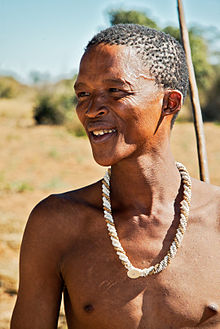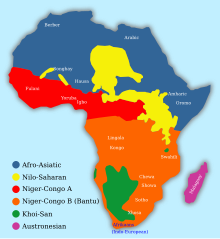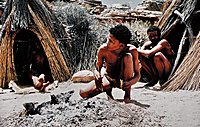利用者:加藤勝憲/コイサン族
 | |
| 総人口 | |
|---|---|
| ~ 400,000[1] (c. 2010) | |
| 居住地域 | |
| Namibia, Botswana, South Africa | |
| 言語 | |
| Afrikaans,[2] Khoe-Kwadi languages, Kx'a languages, Tuu languages | |
| 宗教 | |
| Mainly Christian and African Traditional Religion (San religion) | |
| 関連する民族 | |
| Tswana, Xhosa, Coloured, Griqua |
コイサン[ˈɔɪ] KOY-sahn、またはコエサーン(発音[kxˀ [kxˀoesaː] [kxˀoesaː])、とは、伝統的にバントゥー語以外の言語を話す南部アフリカの先住民族の総称で、コイホーン族とサン族を合わせたものである。コイサン系住民は伝統的にクリック語を話し、南部アフリカ全域の歴史的共同体であると考えられている。ケープ地方Cape regionのようなバントゥー(ソルガム)系農業に不利な気候の地域では、ヨーロッパの植民地化まで優勢であり、ナマ族やダマラ族のコエホエ系住民が多いナミビアやボツワナまで続いた。バントゥー語を話すグループとかなり混血していることは、特に南部アフリカのバントゥー語Southern African Bantu languagesであるホーサ語の多くにクリック音素が見られることからも明らかである。
Khoisan [ˈkɔɪsɑːn] KOY-sahn, or Khoe-Sān (発音 [kxʰoesaːn]発音 [kxʰoesaːn]発音 [kxʰoesaːn]), is a catch-all term for the indigenous peoples of Southern Africa who traditionally speak non-Bantu languages, combining the Khoekhoen
多くのコエサーン人は、15万年前以前にアフリカ南部に飛来した現生人類の子孫である(ただし、コイサーン人が現生人類の源流集団である可能性を示唆する多地域仮説を支持する最近の研究については後述する)[3]。これらのコイサン諸語には漠然とした類型論的類似性が見られるが、それは主にクリック子音が多いことに限られる。共通の原語から派生した言語であることは確認できないが、現在では少なくとも3つの独立した無関係な語族(Khoe-Kwadi、Tuu、Kxʼa)に分かれている。コエクホーは石器時代後期に南部アフリカに到達した民族であり、およそ1,500年から2,000年前にこの地域に到達したバントゥー語の拡大によって追いやられた可能性が指摘されている[4]。
anatomically modern humans
separate and unrelated language families (Khoe-Kwadi, Tuu and Kxʼa). It has been suggested that the Khoekhoe may represent Late Stone Age arrivals to Southern Africa, possibly displaced by Bantu expansion
サーンとは、カラハリ砂漠やボツワナ、ナミビア、アンゴラ、ザンビア、ジンバブエ、レソト、南アフリカ北部の地域で一般的に考えられている採集民のことである。サーンという言葉はコエホエ語に由来し、家畜を所有しない採集者(「地面から物を拾う人」)を指す。そのため、コエホ語と接触するすべての狩猟採集民を指す言葉として使われ、牧畜民や農耕民とは異なるライフスタイルを指すことが多く、特定の民族を指す言葉ではなかった。このような生活様式に付随するコスモロジーや言語は存在するが、この言葉は文化的・民族的なものではなく、経済的な呼称である。
Name
[編集]Khoisan(コイサン)/ Khoesān(コエサーン)という複合語は、20世紀初頭から半ばにかけて使用された近代人類学上の慣例である。Khoisanは1920年代にLeonhard Schulzeによって作られた造語で、Isaac Schaperaによって一般化された[5]。1960年代にはジョーゼフ・グリーンバーグによる「Khoisan」語族という提案に基づいて、より広く使われるようになった。
The compound term Khoisan / Khoesān is a
Isaac Schapera. It entered wider usage from the 1960s based on the proposal of a "Khoisan"
植民地時代/アパルトヘイト時代には、部分的にコーサーン人の祖先を持つアフリカーンス語を話す人々は、歴史的にケープ黒人(アフリカーンス語:Kaap Swartes)または西ケープ黒人(アフリカーンス語:Wes-Kaap Swartes)ともグループ分けされていた:これは、南アフリカのもう1つのアフリカ先住民であるバントゥー語を話す民族と区別するためである[6]。
Cape Blacks (アフリカーンス語: Kaap Swartes) or Western Cape Blacks (アフリカーンス語: Wes-Kaap Swartes) to rather inaccurately distinguish them from the Bantu-speaking peoples
コイサン(KhoiSan、Khoi-San、Khoe-Sanとも表記される)という用語は、1990年代後半のアパルトヘイト終了後、南アフリカの用法にも自称として導入された。2010年代以降、「コイサン活動家」運動が起きており、政府と国内の私有地の大部分を所有する少数派の白人に対して認知と土地の権利を要求している。
The term Khoisan (also spelled KhoiSan, Khoi-San, Khoe-San)

History
[編集]Origins
[編集]
現代のコイサンの祖先は、15万年前より前、おそらく26万年前より前に(東アフリカまたは中央アフリカから)南部アフリカに拡大したことが示唆されている[1][2]、千年前には、アフリカには2つの祖先集団が存在していた。コイ=サンの祖先である南部アフリカのmt-DNAハプログループL0の保持者と、それ以外のすべての人の祖先である中部/東部アフリカのハプログループL1-6の保持者である。[要出典][要出典]このグループは狩猟採集民のサン族を生み出した。この集団は、狩猟採集民であったサンの集団を生み出した。その後、共通時代が始まる頃かそれ以前に移動の波が押し寄せ、牧畜民であったコー族を生み出した[4]。
It is suggested that the ancestors of the modern Khoisan expanded to southern Africa (from East or Central Africa) before 150,000 years ago, possibly as early as before 260,000 years ago,[8] so that by the beginning of the MIS 5 "megadrought" 130,000 years ago, there were two ancestral population clusters in Africa, bearers of mt-DNA haplogroup L0 in southern Africa ancestral to the Khoi-San, and bearers of haplogroup L1-6 in central/eastern Africa ancestral to everyone else.[要出典][citation needed] This group gave rise to the San population of hunter gatherers. A much later wave of migration, around or before the beginning of the Common Era,[9] gave rise to the Khoe people, who were pastoralists.[10] This group carried DNA from Eurasian as well as some Neanderthal groups.
コイサンの祖先となる集団は、その初期の拡大と分離のため、解剖学的に現生人類の時間軸の大部分(150kya以前の初期の分離から約70kyaのユーラシア大陸の人口増加まで)を占める「最大の人類集団」であったと推定されている[11]。彼らは現在よりもずっと広範囲に分布していたが、現代の分布はバンツー族の拡大の過程で壊滅したためである。彼らはアフリカ南部と南東部の大部分に分散していた。また、120~75kyakyaの間に、アフリカ東部へのL0の持ち主の著しい逆移動があった。Rito et al. (2013)は、このような逆移動による圧力が、約70kyaに東アフリカの集団がアフリカから分散する一因になった可能性さえあると推測している[12]。
anatomically modern human
recent peopling of Eurasia
Bantu expansion
最近の研究では、多地域仮説は現在の人類集団の遺伝データによって支持される可能性が示唆されている。ネイチャー』誌に発表された2023年の研究では、現在の遺伝子データは、コイサンの祖先集団を含むアフリカ全土の複数の集団の内部混血を反映していると理解するのが最も適切である可能性が示唆されている[3]。
Late Stone Age
[編集]
コイサンの祖先であるサンの集団は、後期石器時代を通じてアフリカ南部と東部の大部分に広がっていた。L0dハプログループの分布に基づき、約20ka前のさらなる拡大が提唱されている。Rostiらは、この最近の拡大と、アフリカ東部の言語(Hadza語)へのクリック子音の広がりとの関連を示唆している[12]。
石器時代後期のサンゴ人産業は、年間降雨量が1メートル(1000ミリ、39.4インチ)未満の地域でアフリカ南部を占領していた[1]。現代のサン族とコイ族は、古代のサンゴ人の骨格に代表される民族に似ている。
The Late Stone Age Sangoan industry occupied southern Africa in areas where annual rainfall is less than a metre (1000 mm; 39.4 in). The contemporary San and Khoi peoples resemble those represented by the ancient Sangoan skeletal remains.
コイ族とサン族に共通の起源を見出す伝統的な解釈に対して、他の証拠は、コイ族の祖先は比較的最近アフリカ南部に移住したバントゥー以前の農耕民族であり、気候が乾燥するにつれて農耕を放棄し、狩猟採集民としてサン族に加わったか、牧畜生活を維持したことを示唆している[13]。
およそ2,300年前から南部アフリカに牧畜民とバントイド農耕牧畜民が到着したと仮定され、その後、古代コーエサン諸語の子音と借用語がクリックされ、融合した農耕牧畜民と狩猟採集民のコミュニティが進化し、最終的に南アフリカ、ボツワナ、ナミビアに見られる、現存する、統合された現代先住民の言語コミュニティ(南アフリカのコーサ語、ソト語、ツワナ語、ズールー語など)へと発展していった。例えば、南アフリカのホーサ人、ソト人、ツワナ人、ズールー人など)[14]。
With the hypothesized arrival of pastoralists & bantoid agro-pastoralists in southern Africa starting around 2,300 years ago, linguistic development is later seen in the click consonants
(e.g. in South African Xhosa, Sotho, Tswana, Zulu people.)
今日、これらのグループは、現存する混血古代コーサンの子孫の量的な大多数を占め、その数は数百万人にのぼる[15]。
Historical period
[編集]コイ族が歴史に登場するのは、ポルトガル人探検家との最初の接触からである。コイ族がヨーロッパ人から天然痘をうつされた後、地元の人口は減少した。オランダ東インド会社が伝統的な放牧地を牧場に囲い込むと、コイ族はヨーロッパ人に対してより頻繁に攻撃を仕掛けた。コイ族の社会組織は、17世紀後半以降の植民地拡大と土地の収奪によって大きなダメージを受け、最終的には破壊された。社会構造が崩壊するにつれ、一部のコイ族は農場に定住し、束縛者(bondservants)や農場労働者となった。ゲオルク・シュミット(現ドイツ、ザクセン州ヘルンフート出身のモラビア人兄弟)は1738年、アフリカ南部で最初の伝道所となるゲナデンダルをリヴィエゾンデレンデ山地のバヴィアンスクルーフにコイ族の間に設立した[1]。初期のヨーロッパ人入植者はコイ族の女性と結婚することもあり、その結果、現在グリクア族として知られる混血集団が生まれた。グリクア族もまた、当時はコーサ先住民の保護区であった辺境地に移住し、ほとんどがコーサ人であったグリクアランド・イーストを設立した。
Xhosa people. Georg Schmidt, a Moravian Brother from Herrnhut, Saxony, now Germany, founded Genadendal in 1738, which was the first mission station in southern Africa, among the Khoi people in Baviaanskloof in the Riviersonderend Mountains. Early European settlers sometimes intermarried with Khoikhoi women, resulting in a sizeable mixed-race population now known as the Griqua.

Andries Stockenström facilitated the creation of the "Kat River" Khoi settlement near the eastern frontier of the Cape Colony. The settlements thrived and expanded, and Kat River quickly became a large and successful region of the Cape that subsisted more or less autonomously. The people were predominantly Afrikaans-speaking Gonaqua Khoi, but the settlement also began to attract other Khoi, Xhosa and mixed-race groups of the Cape.
The so-called "Bushman wars" were to a large extent the response of the San after their dispossession.[要出典][citation needed]
18世紀初頭、西ケープ州のコイコイ族はオランダ人の支配下にあった。世紀末には、コイサン族の大半は「賃金労働者」として、奴隷とは似ても似つかない生活を営んでいた。地理的に、労働者がケープタウンから離れれば離れるほど、農産物を市場に運ぶのが難しくなった。ベルグ川の北、当時のタルバッグ盆地での放牧許可証の発行は、この地域での植民地拡大を推進した。この土地移転制度によって、コイジュは土地と家畜を失い、社会的、経済的、政治的発展も劇的に変化した[16]。
1853年にホーサ族の反乱が敗北した後、ケープ新政府は将来の人種的不満を回避するため、コイ族に政治的権利を与えることに努めた。同政府は1853年にケープ・フランチャイズCape franchiseを制定し、肌の色に関係なく、低い財産テストに合格したすべての男性市民が選挙権を持ち、議会選挙に出馬できるようにした。この財産テストは、(1812年にオランダから引き継いだ)イギリス領ケープ政府が、人種差別主義に基づく統治システムを維持するための間接的な手段であった[17]。
ドイツ領南西アフリカのヘレロ族とナマクア族の虐殺では、1904年から1907年にかけて1万人以上のナマ族が殺されたと推定されている[18][19]。

The San of the Kalahari were described in Specimens of Bushman Folklore by Wilhelm H. I. Bleek and Lucy C. Lloyd (1911). They were brought to the globalised world's attention in the 1950s by South African author Laurens van der Post in a six-part television documentary. The Ancestral land conflict in Botswana concerns the Central Kalahari Game Reserve (CKGR),
カラハリのサンは、ウィルヘルムH.I.ブリークとルーシーC.ロイドによる『ブッシュマン民俗学の標本』(1911年)に記述されている。彼らは1950年代、南アフリカの作家ローレンス・ヴァン・デア・ポストによって、6部構成のテレビドキュメンタリーでグローバル化した世界の注目を集めた。ボツワナの先祖伝来の土地紛争は、1961年に野生動物のために設立された中央カラハリ・ゲーム保護区(CKGR)に関するもので、サン族は狩猟採集生活を続けることを許されていた。1990年代、ボツワナ政府はCKGRの住民を保護区外に「移転」させる政策を始めた。2002年、政府はCKGRの住民に対するすべてのサービスを打ち切った。法廷闘争が始まり、2006年にはボツワナ高等法院が住民の強制排除は違憲であるとの判決を下した。しかし移転政策は続き、2012年、サン族(バサルワ)は政府に彼らの土地と資源の権利を認めさせるよう国連に訴えた。
1994年のアパルトヘイト終了後、「コイサン」という言葉は、支配者である多数派のバントゥー人に対する南アフリカの「最初の民族」を代表するものとして、南アフリカのコイコイによる自己呼称として徐々に使われるようになった。1997年には西ケープ大学によって「コイサンのアイデンティティと文化遺産」に関する会議が開催され[20]、2015年からは南アフリカのメディアで「コイサン活動」が報道されるようになった。
南アフリカ政府は(1998年まで)、コイサン一族が1913年以前に存在した土地の請求権を追求することを認めていた。南アフリカの土地請求権委員長代理であるタミ・ムドントスワ氏は、コイサン族が1913年6月9日以前に彼らの直接の祖先が連れ去られた土地に対する更なる請求権を追求できるようにするには、憲法改正が必要であると述べている[21]。
-
"Bosjemans frying locusts", aquatint by Samuel Daniell (1805).
-
San woman in Namibia (1984 photograph)
-
Bushman camp 2005
Discoveries
[編集]2019年、フリーステート大学の科学者たちが、コイサン族が作った8000年前の彫刻を発見した。その彫刻は、ヴェレデフォートの衝突構造の「雨の蛇」堤にカバ、馬、カモシカを描いており、コイサン族の雨乞い神話に関する精神的な意味を持っている可能性がある[22]。
University of the Free State
Vredefort impact structure, which may have spiritual significance regarding the rain-making mythology of the Khoisan.
Violence against the Khoisan
[編集]Herero and Namaqua Genocide
[編集]ヘレロ族とナマクア族の大量虐殺では、1904年から1908年にかけてドイツ植民地帝国による絶滅作戦で、約1万人のナマ族、コエホ族、そして未知の数のサン族が殺された。
In the Herero and Namaqua genocide, about 10,000 Nama, a Khoekhoe group, and an unknown number of San people were killed in an extermination campaign by the German Colonial Empire between 1904 and 1908.
Forced relocation in Botswana
[編集]ボツワナでは、先住民であるサン族の多くが、自分たちの土地から保留地に強制移住させられている。移転させるために、彼らは自分の土地での水の利用を拒否され、主な食料源である狩猟をすれば逮捕されることになった[23]。彼らの土地は、世界で最も豊かなダイヤモンド鉱区のど真ん中にある。政府は公式には、採掘との関連性を否定し、サン族は何千年もの間、この土地で持続可能な生活を営んできたにもかかわらず、移転は野生生物と生態系を保護するためだと主張している[23]。保留地では、彼らは職を見つけるのに苦労し、アルコール依存症が蔓延している[23]。
Languages
[編集]
コイサン諸語」は、1955年にジョセフ・グリーンバーグによって言語門として提唱された[24]。20世紀後半にはその遺伝的関係が疑問視されるようになり、現在では、「パプア語」や「オーストラリア語」のように、遺伝的な統一性を意味しない便宜的な用語としての役割がほとんどである[25]。彼らの最も顕著な共通点は、クリック子音である。
これらは2つのファミリーに分類され、多くの言語が分離している可能性がある。
Kxʼaファミリーは2010年に提唱され、ǂʼAmkoe(ǂǂ)言語とǃǃ(Juu)方言群を合わせたものである。ǃǃには約12の方言が含まれ、それらの間に明確な境界線はない。Sandsら(2010)は4つのクラスターに分けることを提案している:
The Kxʼa family was proposed in 2010, combining the ǂʼAmkoe (ǂHoan) language with the ǃKung (Juu)
- Northern ǃKung (Sekele)北部のǃクン(セケレ)、アンゴラのクネネ川、クバンゴ川、クイト川、クアンド川周辺で話されている(ただし、現在はナミビアに多くの難民がいる)、
- North-Central ǃKung (Ekoka), 北中部 ǃクン(エコカ)、オバンボ川とアンゴラ国境の間のナミビアで話されている、
- Central ǃKung, 中央ǃクン:ナミビアのグルートフォンテーン周辺で話されている。Grootfontein, ナミビア、中央オマタコ川の西、オバンボ川の南
- ボツワナのオカバンゴ・デルタ東部と、ナミビア北東部のウィントフック近郊からルンドゥ、ゴバビスに至る地域で話されている。Southeastern ǃKung (Juǀʼhoan), spoken in Botswana east of the Okavango Delta, and northeast Namibia from near Windhoek to Rundu, Gobabis, and the Caprivi Strip.
コイ(Khoe)族は、コイコイ(Khoekhoe方言とKhoemana方言)とカラハリ(Tshu-Khwe)支族に分かれる。カラハリ語族には、シュア語、ツォア語(方言あり)、クソエ語、ナロ語、グアナ語、ǂハバ語(方言あり)が含まれます。Khoeはまた、Kwadi(「Kwadi-Khoe」)とも暫定的に並んでおり、タンザニアのSandawe語(「Khoe-Sandawe」)とも推測されている。タンザニアのハザ語は、クリック子音が存在することから、コイサングループと関連付けられてきた。
The Khoi (Khoe) family is divided into a Khoikhoi (Khoekhoe and Khoemana dialects) and a Kalahari (Tshu–Khwe) branch. The Kalahari branch of Khoe includes Shua and Tsoa (with dialects), and Kxoe, Naro, Gǁana and ǂHaba (with dialects). Khoe also has been tentatively aligned with Kwadi ("Kwadi–Khoe"), and more speculatively with the Sandawe language of Tanzania ("Khoe–Sandawe"). The Hadza language of Tanzania has been associated with the Khoisan group due to the presence of click consonants.
Physical characteristics and genetics
[編集]コイサン人は、東アジア以外で外眼鬚を持つ唯一の民族のひとつである。彼らは通常、可能な限りカールのきつい髪質をしており、頭皮の上で丸く分かれることから「ペッパーコーン」と呼ばれることもある。
kinky hair
チャールズ・ダーウィンは、1882年の『人間の進化と性淘汰』の中で、コイサン族と性淘汰について書いており、主に女性に見られる彼らのステアトピーギアsteatopygiaは、人類の進化における性淘汰によって進化したものであり、「身体の後方部分が最も素晴らしい形で突出している」とコメントしている[26]。歴史的に、一部の女性は小陰唇が伸長していることが人類学者によって観察されており、立ったときに膣口より10cmも下に突出していることがあった[2]。
, seen primarily in females, evolved through sexual selection in human evolution,
そして、「身体の後部が最も素晴らしい方法で突出している」という。歴史的に、一部の女性は小陰唇が伸びていることが人類学者によって観察されており、立ったときに膣口より10センチも下に突き出ていることもあった。[27] よく知られていることではあるが、この慣習の背後にある動機や、それを実践する女性たちの声については、ほとんど調査されていない[28]。
1990年代、世界の民族を対象としたゲノム研究により、サン系男子のY染色体には、他のすべての集団とは異なる特定の多型パターンがあることが判明した[29]。Y染色体は世代間で高度に保存されているため、この種のDNA検査は、異なるサブグループがいつ互いに分離したか、つまり最後の共通祖先を決定するために用いられる。これらの研究の著者は、サンは現存する全人類の最も近い共通父系祖先から分化した最初の集団のひとつであった可能性を示唆した[30][31]。[needs update]
most recent common paternal ancestor
様々なY染色体研究[32][33][34]により、コイサンは最も分岐の激しい(最も古い)Y染色体ハプログループのいくつかを保持していることが確認されている。これらのハプログループはハプログループAとBの特定のサブグループであり、ヒトのY染色体ツリーで最も古い2つの枝である[要更新]。
Y染色体研究からの発見と同様に、ミトコンドリアDNA研究でも、コイサン族がヒトのミトコンドリアDNAツリーで最も古いハプログループの枝を高い頻度で持っているという証拠が示された。ミトコンドリアハプログループの中で最も発散の早い(最も古い)ハプログループであるL0dは、アフリカ南部のコイ族とサン族で最も高い頻度で確認されている[32][35][36][37]。 コイサンが母系と父系の両方のグループにおいて特徴的であることは、彼らが歴史的に他のアフリカ人とは異なる集団であることを示すさらなる指標である[38]。
さらに、いくつかのゲノム研究によって、コイサン集団は過去数千年の間に、ユーラシア人との混血要素を持つ東アフリカの集団から9~30%の遺伝的混血の影響を受けていることが明らかになっている[39]。
さらに、これらの南部アフリカの集団に見られる父系ハプログループE1b1bの起源は東アフリカであり[40]、牧畜業がこの地域に導入されたとも考えられている[41]。同論文はまた、バンツー語の拡大が多くのコイサン・グループに顕著な遺伝的影響を与えたと指摘している[40]。PCA予測に基づくと、コエ=クワディ語を話す人々や他の南部アフリカ人のゲノムで確認された東アフリカの祖先は、タンザニアのルクスマンダLuxmanda出身の個体と関連している[42]。
2024年、遺伝学者が南アフリカのオークハースト岩山から1万年前の古代遺跡を採取した。調査された集団はサン族やコー族と強い遺伝的連続性を持っていた。過去2,000年の間に牧畜と農耕の集団が出現したことで、南部アフリカのほとんどの地域の遺伝子プールは変化したが、多くのコイサンは古い狩猟採集民の遺伝的特徴と同一である[43]。
Centre
[編集]2020年9月21日、ケープタウン大学は新しいコイ・サン・センターを発足させ、次年度には学部学位プログラムを展開する予定である。同センターは、言語(コイホエゴワブを含む)、聖なる遺骨、土地、ジェンダーに関する研究委託について、この共同研究を支援し、統合する。ケープフラッツには、コイサン族の多くの子孫が今も暮らしている[44]。
language (including Khoekhoegowab), sacred human remains, land and gender. Many descendants of Khoisan people still live on the Cape Flats.
関連項目
[編集]- <a href="https://en-two.iwiki.icu/wiki/Bantu_peoples_of_South_Africa" rel="mw:ExtLink" title="Bantu peoples of South Africa" class="cx-link" data-linkid="368">Bantu peoples of South Africa</a>
- <a href="https://en-two.iwiki.icu/wiki/Boskop_Man" rel="mw:ExtLink" title="Boskop Man" class="cx-link" data-linkid="370">Boskop Man</a>
- Early human migrations
- <a href="https://en-two.iwiki.icu/wiki/Ethnic_groups_in_South_Africa" rel="mw:ExtLink" title="Ethnic groups in South Africa" class="cx-link" data-linkid="374">Ethnic groups in South Africa</a>
- <a href="https://en-two.iwiki.icu/wiki/Indigenous_peoples_of_Africa" rel="mw:ExtLink" title="Indigenous peoples of Africa" class="cx-link" data-linkid="376">Indigenous peoples of Africa</a>
- San religion
出典
[編集]- ^ Their total numbers are estimated at roughly 300,000 Khoikhoi and 90,000 San: 200k Nama people (2010): Brenzinger, Matthias (2011) "The twelve modern Khoisan languages." In Witzlack-Makarevich & Ernszt (eds.), Khoisan languages and linguistics: proceedings of the 3rd International Symposium, Riezlern / Kleinwalsertal (Research in Khoisan Studies 29). 100k Damara people (1996): James Stuart Olson, « Damara » in The Peoples of Africa: An Ethnohistorical Dictionary, Greenwood Publishing Group, 1996, p. 137. 50-60k San people in Botswana (2010): Anaya, James (2 June 2010). Addendum – The situation of indigenous peoples in Botswana (PDF) (Report). United Nations Human Rights Council. A/HRC/15/37/Add.2..
- ^ Parkinson, Christian (2016年6月14日). “The first South Africans fight for their rights”. BBC News. "Most [Khoisan people] now speak Afrikaans as their first language."
- ^ a b Ragsdale, Aaron P.; Weaver, Timothy D.; Atkinson, Elizabeth G.; Hoal, Eileen G.; Möller, Marlo; Henn, Brenna M.; Gravel, Simon (2023). “A weakly structured stem for human origins in Africa”. Nature 617 (7962): 755–763. Bibcode: 2023Natur.617..755R. doi:10.1038/s41586-023-06055-y. PMC 10208968. PMID 37198480. 引用エラー: 無効な
<ref>タグ; name "A weakly structured stem for human"が異なる内容で複数回定義されています - ^ Barnard, Alan (1992). Hunters and Herders of Southern Africa: A comparative ethnography of the Khoisan peoples. New York, NY; Cambridge, UK: Cambridge University Press
- ^ Schapera, Isaac (1930). The Khoisan peoples of South Africa: Bushmen and Hottentots. Routledge
- ^ Christopher, A. J. (2002). “'To Define the Indefinable': Population Classification and the Census in South Africa”. Area 34 (4): 401–408. Bibcode: 2002Area...34..401C. doi:10.1111/1475-4762.00097. JSTOR 20004271.
- ^ Behar, Doron M.; Villems, Richard; Soodyall, Himla; Blue-Smith, Jason; Pereira, Luisa; Metspalu, Ene; Scozzari, Rosaria; Makkan, Heeran et al. (2008). “The Dawn of Human Matrilineal Diversity”. The American Journal of Human Genetics 82 (5): 1130–1140. doi:10.1016/j.ajhg.2008.04.002. PMC 2427203. PMID 18439549. "Both the tree phylogeny and coalescence calculations suggest that Khoisan matrilineal ancestry diverged from the rest of the human mtDNA pool 90,000–150,000 years before present (ybp)"
- ^ Schlebusch, Carina M.; Malmström, Helena; Günther, Torsten; Sjödin, Per; Coutinho, Alexandra; Edlund, Hanna; Munters, Arielle R.; Vicente, Mário et al. (2017). “Southern African ancient genomes estimate modern human divergence to 350,000 to 260,000 years ago”. Science 358 (6363): 652–655. Bibcode: 2017Sci...358..652S. doi:10.1126/science.aao6266. PMID 289719702
- ^ Crowe (4 February 2016). “How the origin of the KhoiSan tells us that 'race' has no place in human ancestry”. The Conversation. 4 August 2022閲覧。
- ^ “The Khoisan”. South African History Online (16 January 2020). 4 August 2022閲覧。
- ^ Kim, Hie Lim; Ratan, Aakrosh; Perry, George H.; Montenegro, Alvaro; Miller, Webb; Schuster, Stephan C. (4 December 2014). “Khoisan hunter-gatherers have been the largest population throughout most of modern-human demographic history”. Nature Communications (Nature Publishing Group) 5: 5692. Bibcode: 2014NatCo...5.5692K. doi:10.1038/ncomms6692. PMC 4268704. PMID 254712242
- ^ a b c Rito, Teresa; Richards, Martin B.; Fernandes, Verónica; Alshamali, Farida; Cerny, Viktor; Pereira, Luísa; Soares, Pedro; Gilbert, Tom (2013). “The First Modern Human Dispersals across Africa”. PLOS ONE 8 (11): e80031. Bibcode: 2013PLoSO...880031R. doi:10.1371/journal.pone.0080031. PMC 3827445. PMID 242361712 引用エラー: 無効な
<ref>タグ; name "Rito2013"が異なる内容で複数回定義されています - ^ Güldemann, Tom (2020), “Changing Profile when Encroaching on Forager Territory: Toward the History of the Khoe-Kwadi Family in Southern Africa”, The Language of Hunter-Gatherers (Cambridge University Press): 114–146, doi:10.1017/9781139026208.007, ISBN 978-1-139-02620-8
- ^ Petersen, Desiree C.; Libiger, Ondrej; Tindall, Elizabeth A.; Hardie, Rae-Anne; Hannick, Linda I.; Glashoff, Richard H.; Mukerji, Mitali; Fernandez, Pedro et al. (14 March 2013). “Complex Patterns of Genomic Admixture within Southern Africa”. PLOS Genetics 9 (3): e1003309. doi:10.1371/journal.pgen.1003309. PMC 3597481. PMID 23516368.
- ^ May, Andrew; Hazelhurst, Scott; Li, Yali; Norris, Shane A; Govind, Nimmisha; Tikly, Mohammed; Hon, Claudia; Johnson, Keith J et al. (December 2013). “Genetic diversity in black South Africans from Soweto”. BMC Genomics 14 (1): 644. doi:10.1186/1471-2164-14-644. PMC 3850641. PMID 24059264.
- ^ James, Wilmot Godfrey; Simons, Mary (2008). Class, Caste and Color: A Social and Economic History of the South African Western Cape. Transaction Publishers. pp. 1–10. ISBN 978-1-4128-1970-1
- ^ Fraser (3 June 2013). “A Long Walk To Universal Franchise In South Africa”. Helen Suzman Foundation. Template:Cite webの呼び出しエラー:引数 accessdate は必須です。
- ^ Jeremy Sarkin-Hughes (2008) Colonial Genocide and Reparations Claims in the 21st Century: The Socio-Legal Context of Claims under International Law by the Herero against Germany for Genocide in Namibia, 1904–1908, p. 142, Praeger Security International, Westport, Conn. ISBN 978-0-313-36256-9
- ^ Moses, A. Dirk (2008). Empire, Colony, Genocide: Conquest, Occupation and Subaltern Resistance in World History. New York: Berghahn Books. ISBN 9781845454524
- ^ Hitchcock. “San, Khwe, Basarwa, or Bushmen? Terminology, Identity, and Empowerment in Southern Africa”. Kalahari Peoples Fund. 2 August 2020時点のオリジナルよりアーカイブ。15 January 2014閲覧。
- ^ Mercedes Besent. “SABC News – Possible constitution changes for Khoisan land claims: Wednesday 16 October 2013”. sabc.co.za. 23 November 2016時点のオリジナルよりアーカイブ。11 January 2014閲覧。
- ^ EDT (2019年6月13日). “8,000-year-old carvings by ancient humans discovered in world's biggest asteroid impact crater” (英語). Newsweek. 2020年9月17日閲覧。
- ^ a b c “Botswana bushmen: Modern life is destroying us”. BBC News. (7 January 2014). オリジナルの25 March 2016時点におけるアーカイブ。 24 July 2016閲覧。
- ^ Greenberg, Joseph Harold (1955). Studies in African Linguistic Classification. Compass Publishing Company. OCLC 654476975
- ^ Sands, Bonny Eva (1998). Eastern and Southern African Khoisan: Evaluating Claims of Distant Linguistic Relationships. R. Köppe. ISBN 978-3-89645-142-2
- ^ Charles Darwin (1882). The Descent of Man and Selection in Relation to Sex. London: John Murray. p. 578
- ^ Schapera, Isaac (1930) (English). The Khoisan Peoples of South Africa: Bushmen and Hottentots. London: Routledge & Kegan Paul Ltd.. pp. 59, 62–63, 243
- ^ Bagnol, Brigitte; Mariano, Esmeralda (2008). “Elongation of the labia minora and use of vaginal products to enhance eroticism: Can these practices be considered FGM?”. Finnish Journal of Ethnicity and Migration 3: 42–53 2022年1月28日閲覧。.
- ^ “Dwindling African tribe may have been most populous group on planet”. sciencemag.org
- ^ Schuster, SC (2010). “Complete Khoisan and Bantu genomes from Southern Africa”. Nature 463 (7283): 943–947. Bibcode: 2010Natur.463..943S. doi:10.1038/nature08795. PMC 3890430. PMID 20164927etal
- ^ Mayell, Hillary (December 2002). “Documentary Redraws Humans' Family Tree”. National Geographic. December 22, 2002時点のオリジナルよりアーカイブ。 Template:Cite webの呼び出しエラー:引数 accessdate は必須です。
- ^ a b Knight, Alec; Underhill, Peter A.; Mortensen, Holly M.; Zhivotovsky, Lev A.; Lin, Alice A.; Henn, Brenna M.; Louis, Dorothy; Ruhlen, Merritt et al. (2003). “African Y chromosome and mtDNA divergence provides insight into the history of click languages”. Current Biology 13 (6): 464–73. Bibcode: 2003CBio...13..464K. doi:10.1016/S0960-9822(03)00130-1. PMID 12646128.
- ^ Hammer, Michael F.; Karafet, Tatiana M.; Redd, Alan J.; Jarjanazi, Hamdi; Santachiara-Benerecetti, Silvana; Soodyall, Himla; Zegura, Stephen L. (July 2001). “Hierarchical Patterns of Global Human Y-Chromosome Diversity”. Molecular Biology and Evolution 18 (7): 1189–1203. doi:10.1093/oxfordjournals.molbev.a003906. PMID 11420360.
- ^ “Development of a single base extension method to resolve Y chromosome haplogroups in sub-Saharan African populations”. Investigative Genetics 1 (1): 6. (2010). doi:10.1186/2041-2223-1-6. PMC 2988483. PMID 21092339.
- ^ “mtDNA variation in the South African Kung and Khwe, and their genetic relationships to other African populations”. The American Journal of Human Genetics 66 (4): 1362–83. (2000). doi:10.1086/302848. PMC 1288201. PMID 10739760.
- ^ Tishkoff, SA; Gonder, MK; Henn, BM; Mortensen, H; Knight, A; Gignoux, C; Fernandopulle, N; Lema, G et al. (2007). “History of click-speaking populations of Africa inferred from mtDNA and Y chromosome genetic variation”. Molecular Biology and Evolution 24 (10): 2180–95. doi:10.1093/molbev/msm155. PMID 176566338
- ^ “SNaPshot minisequencing to resolve mitochondrial macro-haplogroups found in Africa”. Electrophoresis 30 (21): 3657–64. (2009). doi:10.1002/elps.200900197. PMID 19810027.
- ^ Pickrell, Joseph K.; Patterson, Nick; Loh, Po-Ru; Lipson, Mark; Berger, Bonnie; Stoneking, Mark; Pakendorf, Brigitte; Reich, David (18 February 2014). “Ancient west Eurasian ancestry in southern and eastern Africa”. Proceedings of the National Academy of Sciences 111 (7): 2632–2637. arXiv:1307.8014. Bibcode: 2014PNAS..111.2632P. doi:10.1073/pnas.1313787111. PMC 3932865. PMID 24550290.
- ^ Schlebusch, Carina M.; Malmström, Helena; Günther, Torsten; Sjödin, Per; Coutinho, Alexandra; Edlund, Hanna; Munters, Arielle R.; Vicente, Mário et al. (2017-11-03). “Southern African ancient genomes estimate modern human divergence to 350,000 to 260,000 years ago”. Science 358 (6363): 652–655. Bibcode: 2017Sci...358..652S. doi:10.1126/science.aao6266. ISSN 1095-9203. PMID 28971970.
- ^ a b Bajić, Vladimir; Barbieri, Chiara; Hübner, Alexander; Güldemann, Tom; Naumann, Christfried; Gerlach, Linda; Berthold, Falko; Nakagawa, Hirosi et al. (2018-09-07). “Genetic structure and sex-biased gene flow in the history of southern African populations” (英語). American Journal of Physical Anthropology 167 (3): 656–671. doi:10.1002/ajpa.23694. ISSN 0002-9483. PMC 6667921. PMID 30192370.
- ^ Vicente, Mário; Lankheet, Imke; Russell, Thembi; Hollfelder, Nina; Coetzee, Vinet; Soodyall, Himla; Jongh, Michael De; Schlebusch, Carina M. (2021-12-07). “Male-biased migration from East Africa introduced pastoralism into southern Africa”. BMC Biology 19 (1): 259. doi:10.1186/s12915-021-01193-z. ISSN 1741-7007. PMC 8650298. PMID 34872534.
- ^ Oliveira, Sandra; Fehn, Anne-Maria; Amorim, Beatriz; Stoneking, Mark; Rocha, Jorge (2023). “Genome-wide variation in the Angolan Namib Desert reveals unique pre-Bantu ancestry”. Science Advances 9 (38): eadh3822. Bibcode: 2023SciA....9H3822O. doi:10.1126/sciadv.adh3822. ISSN 2375-2548. PMC 10516492. PMID 37738339.
- ^ Gretzinger, Joscha; Gibbon, Victoria E.; Penske, Sandra E.; Sealy, Judith C.; Rohrlach, Adam B.; Salazar-García, Domingo C.; Krause, Johannes; Schiffels, Stephan (2024-09-19). “9,000 years of genetic continuity in southernmost Africa demonstrated at Oakhurst rockshelter” (英語). Nature Ecology & Evolution: 1–14. doi:10.1038/s41559-024-02532-3. ISSN 2397-334X.
- ^ Swingler (23 September 2020). “UCT launches milestone Khoi and San Centre”. UCT News. University of Cape Town. 4 January 2021閲覧。
Bibliography
[編集]- Barnard, Alan (2004) Mutual Aid and the Foraging Mode of Thought: Re-reading Kropotkin on the Khoisan. Social Evolution & History 3/1: 3–21.
- Coon, Carleton: The Living Races of Man (1965)
- Diamond, Jared (1999). Guns, Germs, and Steel. New York: W.W. Norton & Company. ISBN 978-0-393-31755-8.
- Hogan, C. Michael (2008) "Makgadikgadi" at Burnham, A. (editor) The Megalithic Portal
- Lee, Richard B. (1979), The ǃKung San: Men, Women, and Work in a Foraging Society. Cambridge: Cambridge University Press.
- Smith, Andrew; Malherbe, Candy; Guenther, Mat and Berens, Penny (2000), Bushmen of Southern Africa: Foraging Society in Transition. Athens: Ohio University Press. ISBN 0-8214-1341-4ISBN 0-8214-1341-4
- Thomas, Elizabeth Marshall (1958, 1989) The Harmless People.
- Thomas, Elizabeth Marshall (2006). The Old Way: A Story of the First People.
External links
[編集]- The Khoisan-speaking Peoples
- The Khoisan
- Home of the Southern African San
- "Khoesan languages" from Web Resources for African Languages
- Africa's Khoe-San were first to split from other humans
- Khoisan people represent 'earliest' branch off human family tree, By Ian Steadman, 24 September 2012.
- Traditional and Khoi-San Leadership Act, 2019
[[Category:未査読の翻訳があるページ]]



